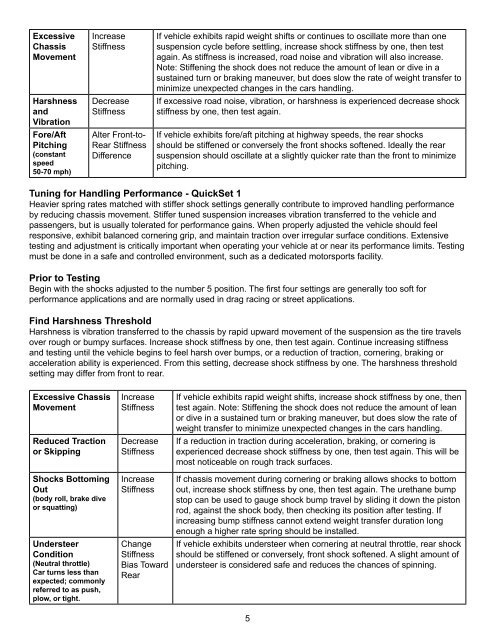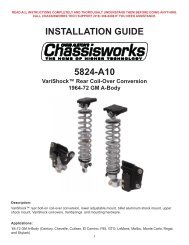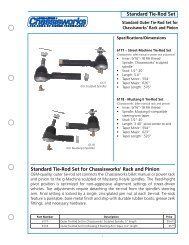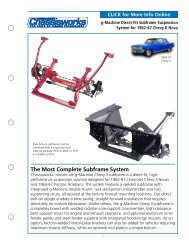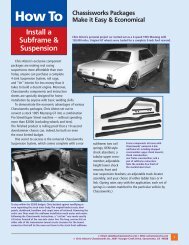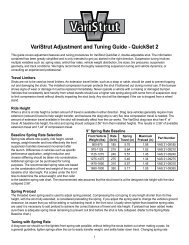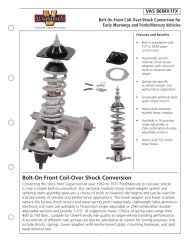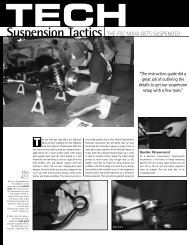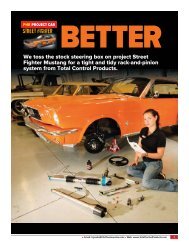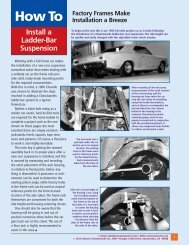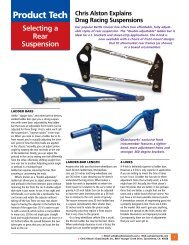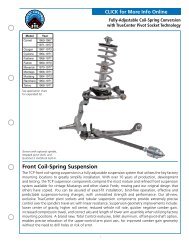Installation Instructions - Chris Alston's Chassisworks
Installation Instructions - Chris Alston's Chassisworks
Installation Instructions - Chris Alston's Chassisworks
You also want an ePaper? Increase the reach of your titles
YUMPU automatically turns print PDFs into web optimized ePapers that Google loves.
ExcessiveChassisMovementHarshnessandVibrationFore/AftPitching(constantspeed50-70 mph)IncreaseStiffnessDecreaseStiffnessAlter Front-to-Rear StiffnessDifferenceIf vehicle exhibits rapid weight shifts or continues to oscillate more than onesuspension cycle before settling, increase shock stiffness by one, then testagain. As stiffness is increased, road noise and vibration will also increase.Note: Stiffening the shock does not reduce the amount of lean or dive in asustained turn or braking maneuver, but does slow the rate of weight transfer tominimize unexpected changes in the cars handling.If excessive road noise, vibration, or harshness is experienced decrease shockstiffness by one, then test again.If vehicle exhibits fore/aft pitching at highway speeds, the rear shocksshould be stiffened or conversely the front shocks softened. Ideally the rearsuspension should oscillate at a slightly quicker rate than the front to minimizepitching.Tuning for Handling Performance - QuickSet 1Heavier spring rates matched with stiffer shock settings generally contribute to improved handling performanceby reducing chassis movement. Stiffer tuned suspension increases vibration transferred to the vehicle andpassengers, but is usually tolerated for performance gains. When properly adjusted the vehicle should feelresponsive, exhibit balanced cornering grip, and maintain traction over irregular surface conditions. Extensivetesting and adjustment is critically important when operating your vehicle at or near its performance limits. Testingmust be done in a safe and controlled environment, such as a dedicated motorsports facility.Prior to TestingBegin with the shocks adjusted to the number 5 position. The first four settings are generally too soft forperformance applications and are normally used in drag racing or street applications.Find Harshness ThresholdHarshness is vibration transferred to the chassis by rapid upward movement of the suspension as the tire travelsover rough or bumpy surfaces. Increase shock stiffness by one, then test again. Continue increasing stiffnessand testing until the vehicle begins to feel harsh over bumps, or a reduction of traction, cornering, braking oracceleration ability is experienced. From this setting, decrease shock stiffness by one. The harshness thresholdsetting may differ from front to rear.Excessive ChassisMovementReduced Tractionor SkippingShocks BottomingOut(body roll, brake diveor squatting)UndersteerCondition(Neutral throttle)Car turns less thanexpected; commonlyreferred to as push,plow, or tight.IncreaseStiffnessDecreaseStiffnessIncreaseStiffnessChangeStiffnessBias TowardRearIf vehicle exhibits rapid weight shifts, increase shock stiffness by one, thentest again. Note: Stiffening the shock does not reduce the amount of leanor dive in a sustained turn or braking maneuver, but does slow the rate ofweight transfer to minimize unexpected changes in the cars handling.If a reduction in traction during acceleration, braking, or cornering isexperienced decrease shock stiffness by one, then test again. This will bemost noticeable on rough track surfaces.If chassis movement during cornering or braking allows shocks to bottomout, increase shock stiffness by one, then test again. The urethane bumpstop can be used to gauge shock bump travel by sliding it down the pistonrod, against the shock body, then checking its position after testing. Ifincreasing bump stiffness cannot extend weight transfer duration longenough a higher rate spring should be installed.If vehicle exhibits understeer when cornering at neutral throttle, rear shockshould be stiffened or conversely, front shock softened. A slight amount ofundersteer is considered safe and reduces the chances of spinning.


